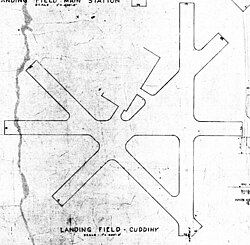 | Review waiting, please be patient.
This may take 2 months or more, since drafts are reviewed in no specific order. There are 1,748 pending submissions waiting for review.
Where to get help
How to improve a draft
You can also browse Wikipedia:Featured articles and Wikipedia:Good articles to find examples of Wikipedia's best writing on topics similar to your proposed article. Improving your odds of a speedy review To improve your odds of a faster review, tag your draft with relevant WikiProject tags using the button below. This will let reviewers know a new draft has been submitted in their area of interest. For instance, if you wrote about a female astronomer, you would want to add the Biography, Astronomy, and Women scientists tags. Editor resources
Reviewer tools
|
| NAAS Cuddihy | |||||||
|---|---|---|---|---|---|---|---|
NOLF Cuddihy | |||||||
| Corpus Christi, Texas, United States | |||||||
 Blueprint of Cuddihy 1940s | |||||||
| Coordinates | 27°43′15″N 97°30′40″W / 27.72083°N 97.51111°W | ||||||
| Type | Naval Auxiliary Air Station/Naval Outlying Landing Field | ||||||
| Site information | |||||||
| Controlled by | United States Navy | ||||||
| Condition | Operational | ||||||
| Site history | |||||||
| Built | 1941 | ||||||
| In use | 1941–1960 (present) | ||||||
| Events | World War II | ||||||
| Airfield information | |||||||
| |||||||
NAAS Cuddihy, (also known as Naval Outlying Landing Field Cuddihy/NOLF Cuddihy) it was established in 1941 as one of three satellite fields supporting Naval Auxiliary Air Station (NAAS) Corpus Christi during World War II. Located south of Corpus Christi International Airport, the airfield played a crucial role in training naval aviators.
History
editEstablished in 1941 during World War II. It served as one of three outlying landing fields supporting Naval Air Station Corpus Christi, primarily for training naval aviators. The airfield was named after Naval Aviator Lieutenant Richard F. Cuddihy, who had died in an aircraft accident in 1937. The airfield featured a distinctive eight-runway, star-shaped layout, a design common among auxiliary fields in the Corpus Christi area during that era. This configuration facilitated efficient flight operations and training exercises.[1][2]
NAAS Cuddihy was important for the Navy’s efforts to train pilots during the war, providing skilled aviators for combat and patrol operations.[1] The field featured an eight-runway, star-shaped layout, enabling takeoffs and landings in any wind condition. This layout, along with multiple hangars, barracks, and support facilities, reflected the high activity level during wartime.[1]
The establishment of Cuddihy Field was part of a broader expansion of naval aviation facilities in Texas during the early 1940s. This expansion included the development of other auxiliary fields such as the Kingsville Naval Outlying Fields and Cabaniss Field. These facilities were built according to the Navy's plan to train and deploy skilled aviators for combat operations.[3] The construction of Cuddihy Field and its counterparts was overseen by the Defense Plant Corporation, founded in 1941 to expedite the development of defense-related infrastructure.[3]
George T. Cuddihy Incident
editFollowing his graduation, Lieutenant Cuddihy became the Navy's chief test pilot, a role in which he was instrumental in evaluating and advancing naval aircraft technology. During his service, Cuddihy dedicated himself to enhancing the performance and safety of naval aviation.[4]
On November 25, 1929, at the age of 33, Lieutenant Cuddihy lost his life while testing a Bristol Type 105 Bulldog II fighter (Bu. No. A8485) at Anacostia Naval Air Station. Reports stated that the aircraft's wings detached during a high-speed maneuver, which led to the fatal accident. The airfield was named in his honor.[4]
Post-War & Decimmissioning
editAfter World War II, the air station remained operational, continuing to support Naval Air Station Corpus Christi. However, as aviation technology advanced and military requirements changed, the field's role diminished. By the 1960s, NAAS Cuddihy saw reduced activity.[1][2]
Decommissioning
editCuddihy Field continued to operate under the jurisdiction of NAS Corpus Christi. However, after its closure as a military installation in the late 20th century, the airfield was requisitioned for civil aviation. It is now known as Cuddihy Field Airport, designated 07TE.[1][2]
See Also
editReferences
edit- ^ a b c d e "Airfields TX Corpus Cuddihy". Retrieved 20 October 2024.
- ^ a b c "Naval Air Station Corpus Christi". Retrieved 30 November 2024.
- ^ a b "US name memorial hall". Retrieved 26 July 2022.
